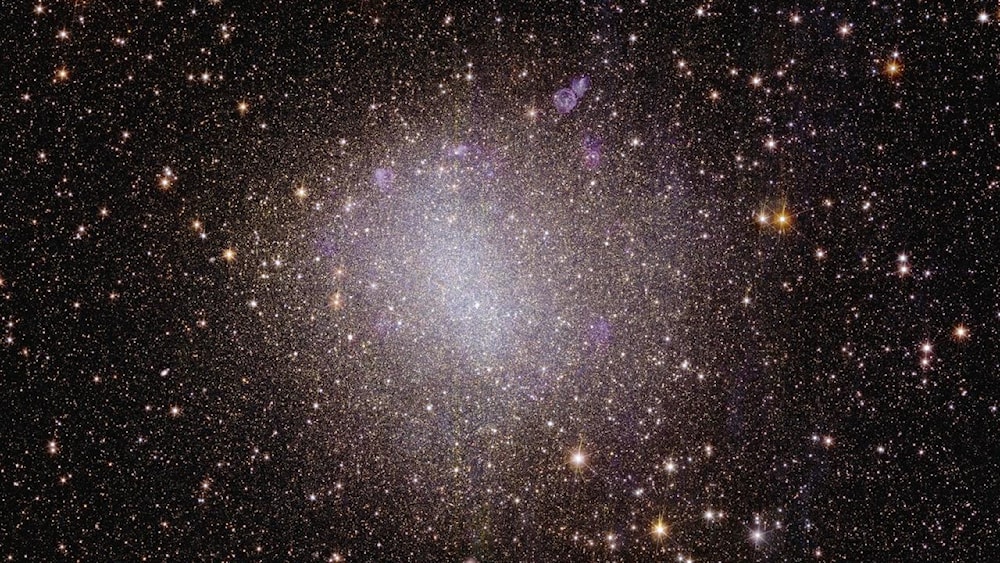New gravity theory: Dark matter might not exist, only a mirage
Physician Jonathan Oppenheim claims in a new paper that the expansion of the universe and galactic rotation can be explained without dark matter or dark energy.
-

The irregular dwarf galaxy NGC 6822 as seen from the Euclid space telescope in 2023 (AFP)
According to conventional scientific understanding, dark matter is believed to make up 85 percent of the mass in the universe.
However, advocates of a radical new theory of gravity, which posits that space-time is "wobbly," suggest that their approach could make the elusive substance unnecessary, The Guardian said in a report on Saturday, citing a newly published research paper.
The proposal, as per the paper, suggests the contentious idea that dark matter, a substance that has never been directly detected, is an illusion that a significant portion of the physics community has been going after for many years.
Read more: SpaceX puts Euclid Telescope into orbit to study Dark Matter
Announcing the paper on X, Professor Jonathan Oppenheim, of University College London, said: “Folks, something seems to be happening. We show that our theory of gravity … can explain the expansion of the universe and galactic rotation without dark matter or dark energy.”
Folks, something seems to be happening... We show that our theory of gravity is valid down to the shortest distances https://t.co/SZvD0TGw90. and that it can explain the expansion of the universe and galactic rotation without dark matter or dark energy https://t.co/GzXBvXYd7K 1/
— Jonathan Oppenheim (@postquantum) March 1, 2024
Despite various lines of evidence supporting its existence, dark matter's nature has remained enigmatic, and searches conducted by the Large Hadron Collider have yielded no results. Last year, the European Space Agency launched the Euclid mission, which aims to create a cosmic map of dark matter.
The most recent paper, which has been published on the Arxiv website and has not yet undergone peer review, raises doubts about the existence of dark matter. It draws comparisons between dark matter and past flawed concepts like "the ether," an invisible substance once believed to fill all of space.
Read more: Space race; Cosmic dash to the dark side of the moon
“In the absence of any direct evidence for dark energy or dark matter it is natural to wonder whether they may be unnecessary scientific constructs like celestial spheres, ether, or the planet Vulcan, all of which were superseded by simpler explanations,” it states. “Gravity has a long history of being a trickster.”
In this case, after spending 5 years in research, Oppenheim proposed a simpler explanation under his theory dubbed the “postquantum theory of classical gravity”.
His approach seeks to reconcile the two fundamental pillars of modern physics: quantum theory and Einstein's general relativity, which are inherently incompatible.
'Without the need of dark matter'
The professor's theory imagines space-time's fabric as smooth and continuous in a classical sense, yet fundamentally unstable.
Time would fluctuate erratically, akin to a bubbling brook, with space warping unpredictably and time behaving differently across various parts of the universe. The theory also suggests an inherent loss of predictability.
The article argues that this perspective on the universe might provide an explanation for significant observations of rotating galaxies that led to the "discovery" of dark matter.
According to the paper, stars on the outskirts of galaxies, where gravity from visible matter is presumed to be weakest, should rotate more slowly than those closer to the center. However, observations show that the orbital speed of stars does not decrease as expected. Astronomers inferred the existence of a halo of undetectable (dark) matter exerting gravitational influence from this discrepancy.
Read more: NASA to launch year long experiment to simulate life on Mars
Oppenheim suggests that the extra energy needed to maintain the stars' orbits is supplied by the random fluctuations in spacetime, effectively creating a background gravitational "hum." This effect would be minor in high-gravity scenarios like the Earth orbiting the Sun. However, in low-gravity environments such as the outskirts of a galaxy, this phenomenon would be significant, potentially explaining the majority of the energy in the universe when considered cumulatively.
“We show that it can explain the expansion of the universe and galactic rotation curves without the need for dark matter or dark energy,” he said on X.
“We do urge caution, however, since there is other indirect evidence for dark matter, so further calculations and comparison with data are needed. But if it holds, it would appear that 95% of the energy in the universe is due to the erratic nature of spacetime, signalling either a fundamental breakdown in predictability of physics, or we are immersed in an environment which does not obey the laws of classical or quantum theory.”
Read more: Unprecedented space debris penalty: US fines dish network

 4 Min Read
4 Min Read








